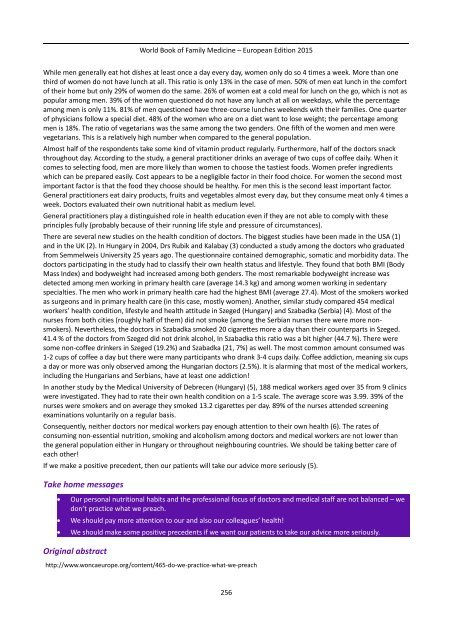Family Medicine
U8UQp
U8UQp
Create successful ePaper yourself
Turn your PDF publications into a flip-book with our unique Google optimized e-Paper software.
World Book of <strong>Family</strong> <strong>Medicine</strong> – European Edition 2015<br />
While men generally eat hot dishes at least once a day every day, women only do so 4 times a week. More than one<br />
third of women do not have lunch at all. This ratio is only 13% in the case of men. 50% of men eat lunch in the comfort<br />
of their home but only 29% of women do the same. 26% of women eat a cold meal for lunch on the go, which is not as<br />
popular among men. 39% of the women questioned do not have any lunch at all on weekdays, while the percentage<br />
among men is only 11%. 81% of men questioned have three-course lunches weekends with their families. One quarter<br />
of physicians follow a special diet. 48% of the women who are on a diet want to lose weight; the percentage among<br />
men is 18%. The ratio of vegetarians was the same among the two genders. One fifth of the women and men were<br />
vegetarians. This is a relatively high number when compared to the general population.<br />
Almost half of the respondents take some kind of vitamin product regularly. Furthermore, half of the doctors snack<br />
throughout day. According to the study, a general practitioner drinks an average of two cups of coffee daily. When it<br />
comes to selecting food, men are more likely than women to choose the tastiest foods. Women prefer ingredients<br />
which can be prepared easily. Cost appears to be a negligible factor in their food choice. For women the second most<br />
important factor is that the food they choose should be healthy. For men this is the second least important factor.<br />
General practitioners eat dairy products, fruits and vegetables almost every day, but they consume meat only 4 times a<br />
week. Doctors evaluated their own nutritional habit as medium level.<br />
General practitioners play a distinguished role in health education even if they are not able to comply with these<br />
principles fully (probably because of their running life style and pressure of circumstances).<br />
There are several new studies on the health condition of doctors. The biggest studies have been made in the USA (1)<br />
and in the UK (2). In Hungary in 2004, Drs Rubik and Kalabay (3) conducted a study among the doctors who graduated<br />
from Semmelweis University 25 years ago. The questionnaire contained demographic, somatic and morbidity data. The<br />
doctors participating in the study had to classify their own health status and lifestyle. They found that both BMI (Body<br />
Mass Index) and bodyweight had increased among both genders. The most remarkable bodyweight increase was<br />
detected among men working in primary health care (average 14.3 kg) and among women working in sedentary<br />
specialties. The men who work in primary health care had the highest BMI (average 27.4). Most of the smokers worked<br />
as surgeons and in primary health care (in this case, mostly women). Another, similar study compared 454 medical<br />
workers’ health condition, lifestyle and health attitude in Szeged (Hungary) and Szabadka (Serbia) (4). Most of the<br />
nurses from both cities (roughly half of them) did not smoke (among the Serbian nurses there were more nonsmokers).<br />
Nevertheless, the doctors in Szabadka smoked 20 cigarettes more a day than their counterparts in Szeged.<br />
41.4 % of the doctors from Szeged did not drink alcohol, In Szabadka this ratio was a bit higher (44.7 %). There were<br />
some non-coffee drinkers in Szeged (19.2%) and Szabadka (21, 7%) as well. The most common amount consumed was<br />
1-2 cups of coffee a day but there were many participants who drank 3-4 cups daily. Coffee addiction, meaning six cups<br />
a day or more was only observed among the Hungarian doctors (2.5%). It is alarming that most of the medical workers,<br />
including the Hungarians and Serbians, have at least one addiction!<br />
In another study by the Medical University of Debrecen (Hungary) (5), 188 medical workers aged over 35 from 9 clinics<br />
were investigated. They had to rate their own health condition on a 1-5 scale. The average score was 3.99. 39% of the<br />
nurses were smokers and on average they smoked 13.2 cigarettes per day. 89% of the nurses attended screening<br />
examinations voluntarily on a regular basis.<br />
Consequently, neither doctors nor medical workers pay enough attention to their own health (6). The rates of<br />
consuming non-essential nutrition, smoking and alcoholism among doctors and medical workers are not lower than<br />
the general population either in Hungary or throughout neighbouring countries. We should be taking better care of<br />
each other!<br />
If we make a positive precedent, then our patients will take our advice more seriously (5).<br />
Take home messages<br />
<br />
<br />
<br />
Our personal nutritional habits and the professional focus of doctors and medical staff are not balanced – we<br />
don’t practice what we preach.<br />
We should pay more attention to our and also our colleagues’ health!<br />
We should make some positive precedents if we want our patients to take our advice more seriously.<br />
Original abstract<br />
http://www.woncaeurope.org/content/465-do-we-practice-what-we-preach<br />
256



